Nokia Lumia 830 Review
by Brett Howse on November 25, 2014 8:00 AM EST- Posted in
- Smartphones
- Microsoft
- Lumia
Camera
The Lumia 830 carries the PureView branding on the camera, which Nokia has saved for the heavy hitting cameras. As the line has evolved, the PureView brand appears to be for phones with Optical Image Stabilization (OIS), although as with any branding that may change in the future. The Lumia 830 is by far the lowest end PureView camera so far, with just a 1/3.4” sensor size attached to the OIS mechanism and the six lens optics. The 10.0 megapixel count results in the typical for Lumia 1.1 µm pixel size. The sensor is also a 16x9 native format. The flash is handled by a single LED. It is good to see OIS in a midrange device such as this but the small sensor and small pixel size is going to limit the amount of data that can be collected in dim lighting even with OIS allowing the exposure time to be a bit longer than normal.
To measure camera performance we start with the ISO12233 chart which allows us to test for spatial resolution as well as the amount of processing done by the ISP to get rid of aliasing.
ISO12233 Test Chart
With a smaller sensor size and the same small pixel size, the Lumia 830 cannot do the pixel binning of its PureView brethren. The ISO chart reveals that this is not the same PureView as other devices with the same branding.

Once we dig into the chart a bit, we can see that the Lumia 830 starts to struggle around the 13 mark on our chart. This is not all about pixel count either, as the lower resolution iPhone can capture up until the 15 mark. The Lumia 930, with its much larger 1/2.5” sensor can pretty much resolve the entire chart and the Lumia 1020 with the PureView 41 MP camera easily resolves the sagittal lines.
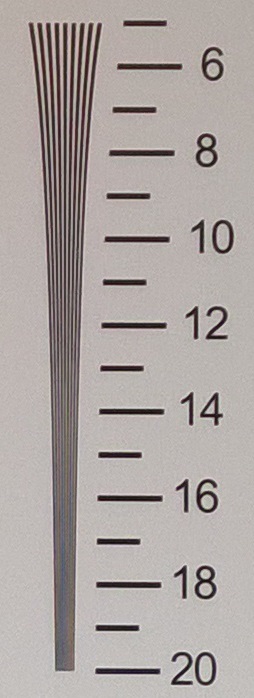
The tangential lines show a similar story, with the Lumia 830 unable to resolve after around the 13 mark. With a 10 MP sensor, I would have hoped to see it resolve at least the same as the iPhone.
Next we will take a look at some controlled scenes.
Controlled Scenes
The Lumia 830 does a good job on a well-lit scenes. The amount of detail is good, and the color balance is very good as well. These shots were taken in full auto, so while it would be possible to correct the Lumia 1020 white balance with the manual controls, most of the time people just leave the camera in auto so it is important for the device to get the right cast.
To stress the camera under poor lighting, we set the light box to 5 lux and leave the flash off. The Lumia 830 does a decent job here again, once again getting the white balance spot on. As compared to the Lumia 1020 photo, there is quite a bit more noise in the final image which is not surprising with the sensor size difference. If you were not going to crop this image it would be very usable.
Outdoor Scenes (Night)
Moving out of the comforts of home, I braved the elements to get some outdoor pictures. The first scene is a park bench which is lit by a low-pressure sodium-vapor light which has a distinctive yellow hue. This scene is dark enough that the image preview on the phone is pretty hard to make out.
The Lumia 830 does a good job with this scene. It keeps some of the yellow cast of the sodium light, but the result is a very usable photo. If you zoom in on it, there is more noise than the 1020 but the overall result is very good.
The picture of the grocery store tells a similar tale. The Lumia 830 gets a better white balance than the Lumia 1020 and the result is a good photo. The Lumia 1020 as always struggles to get the correct white balance when in auto mode even though the resultant picture has much less noise.
Outdoor Scenes (Day)
Moving to daytime, there is generally ample light that even small sensors have no issue getting a reasonable photo.
The Lumia 830 had no issues during daylight with any of the subjects. This picture makes a great comparison with the detail loss as compared to the Lumia 1020. Please ignore the color differences between the photos as the sun ducked behind a cloud, but instead look at the detail of a zoomed in image.
 Lumia 830 (Left) vs Lumia 1020 (right) in Cropped comparison - view at full resolution to see full effect
Lumia 830 (Left) vs Lumia 1020 (right) in Cropped comparison - view at full resolution to see full effect
The Lumia 830 is a good camera for basic point and shoot smartphone photography but it lacks the imaging power of the other PureView phones such as the 930 and 1020. A 1/3.4” sensor and the much lower pixel count removes the ability to do pixel binning to improve the overall result, and it also removes the ability to do lossless zoom.
Another missing feature from the Lumia 830 as compared to the other PureView cameras is the ability to capture in RAW format.
As a still photograph camera, we still need to look at one more feature that can impact camera use – latency.
Capture Latency
Being able to take a photograph quickly can mean the difference between getting a great shot and missing the subject altogether. We have seen a great push in the industry in the last while to improve the focus latency, with some cameras now using phase detection and other tricks to increase the focus speed. The other half of that is the capture latency of taking the photo and saving it so that the camera app is ready to go again. We will start with focus. As with the performance benchmarks, I sampled several phones that may be shopped against the Lumia 830. If you want to check out the 830 against any other device, please visit our benchmark comparison pages in Bench.
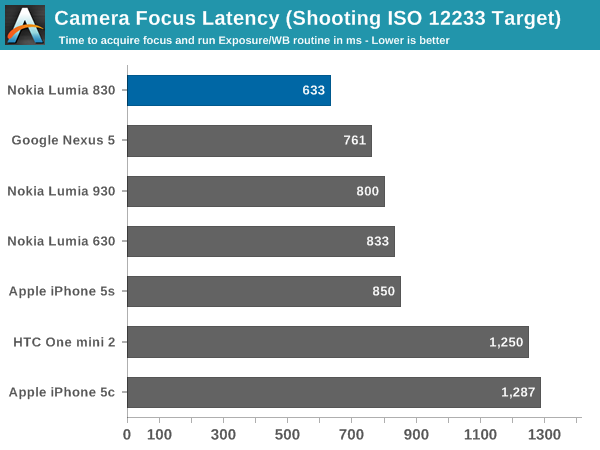
The Lumia 830 is the fastest Lumia I have tested for focus latency, with it occurring in just over 600 ms. While not the outright fastest device for focus we have ever tested, improvement is always welcome. Next up, we will look at the latency to initiate a photo save it to disk.
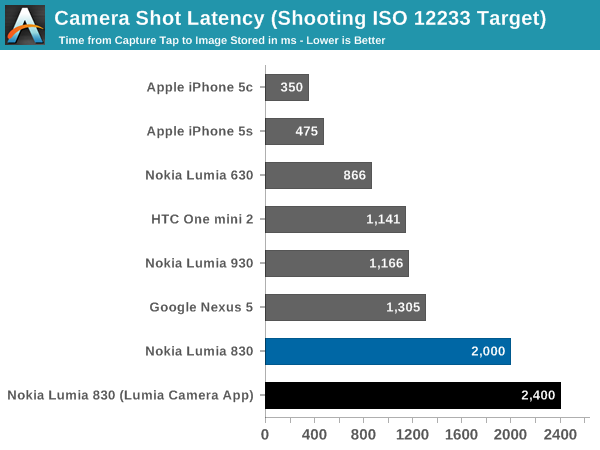
At IFA, Microsoft announced they were going to be launching a new camera app at the end of this year and it cannot come soon enough. The Lumia Camera app is especially slow, with a total capture latency of 2.4 seconds before it is ready for another shot. The default Windows Phone camera app is slightly faster at 2 seconds even. The Lumia 930 outperforms it here which likely means that it is being held back by the slower SoC onboard.
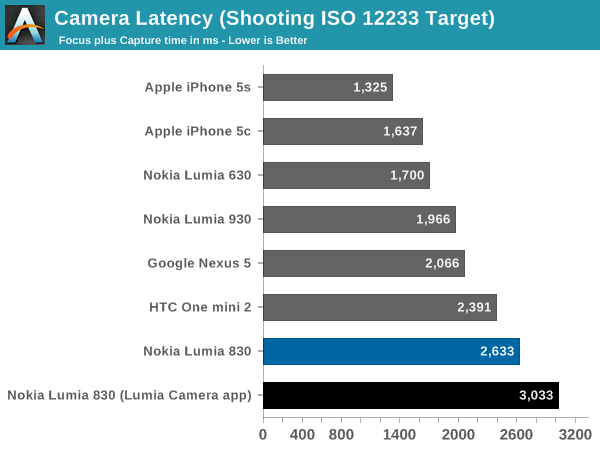
Total latency is the time to focus and the time to capture and save the image. The Lumia 830 is a very slow camera. It is hard to say anymore other than hopefully the new camera app improves this situation.
Video
The 830 has four microphones which allow it to capture video in Dolby Digital surround sound, which is a nice bonus. The video resolution and frame rate options are fairly sparse though, with the only options being 1080p or 720p at 24, 25, or 30 frames per second.
I did two videos with the first one being during the day and the second one at night.
The video during the day was during very high winds (50 km/h+) and with the default low pass filter enabled on the video the amount of wind noise was pretty good.
The night video shows the limits of the sensor quite clearly. OIS helps with the camera shake, but on still photography it allows for an increased exposure time to combat a small sensor. On a video, the sensor gets no such bonus and as such there is quite a bit of noise.


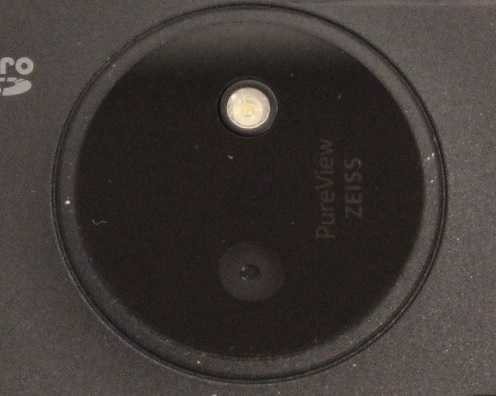
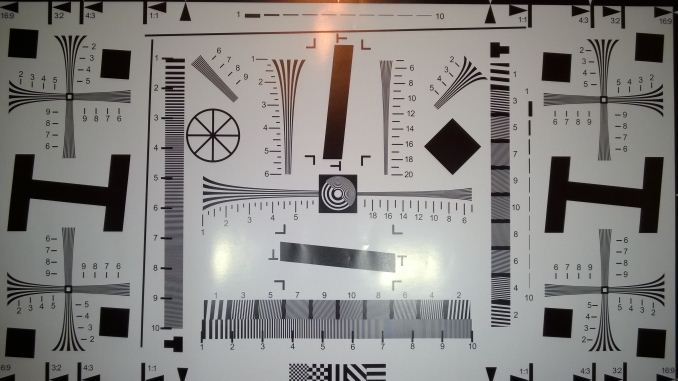


















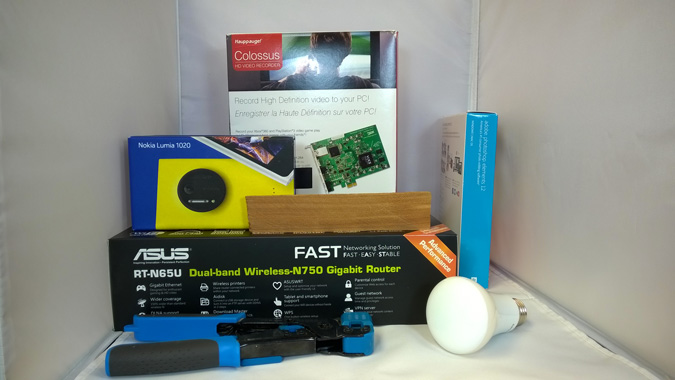


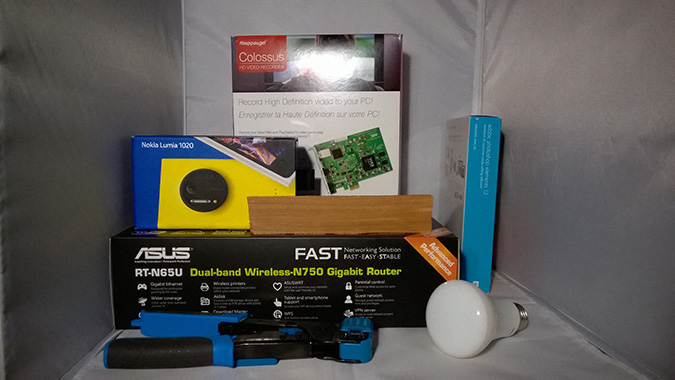





















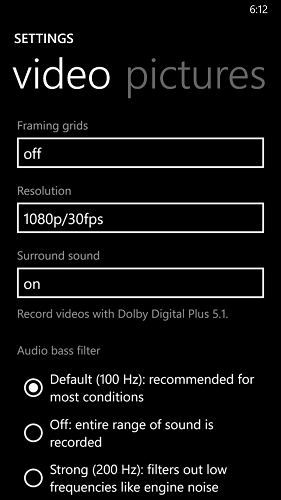








98 Comments
View All Comments
Daniel Egger - Tuesday, November 25, 2014 - link
Well, I called it months ago that this phone is in many ways inferior to its predecessor. Would have been nice to include the benchmarks for the 820 but I already have a good idea on how that would compare.@Microsoft, sign me up for the next phone with a <5" OLED display that is run by something else than those measly entry level Cortex A7s, no problem if it's "just" a dual-core...
BedfordTim - Tuesday, November 25, 2014 - link
Add me to the list too. Changing to a smaller phone was a revelation and I don't want to go back to carting a tablet around all the time.LittleB69 - Tuesday, November 25, 2014 - link
Been waiting for a new flagship model with Glance support from Microsoft. It has not arrived yet so I am sticking with my 920. Actually I have been thinking about going back to Android. Moved from Apple to HTC (Android) and from Android to Windows Phone. Was pretty happy as an Android user. After being without my WP for less than a week and using a S4.. I am staying on WP for sure :-)Gunbuster - Tuesday, November 25, 2014 - link
I'm in pretty much the same boat. Waiting for an upper end SOC, Qi charging, Glance, and Hey Cortana, and a good camera. How hard is it to just check all the boxes.P.S. they need to figure out cross carrier WiFi calling and then just sell it unlocked through the Microsoft store supporting ATT and T-Mobile.
tolgerias - Tuesday, November 25, 2014 - link
As the owner of a Lumia 920 I am very interested in this phone. I know it's not a flagship, but I love the design and I prefer the 5" screen even though it is only 720p. If I could find this phone for $300 off contract I would buy it instantly, so I'll keep an eye out for it. There are a few things that would be an upgrade for me:1. 5" vs 4.5" screen
2. Sensor Core
3. Thinner and lighter design
4. Newer SoC
Last year I bought an iPhone 5s on my contract renewal, but even though I like iOS 8, I find myself going back to my 920 most of the time. I just love the amount of information WP 8.1 provides me at a glance. Live tiles, glance screen, and wireless charging are absolutely brilliant and always miss them when I am on a phone that doesn't have them.
So I'll stick with my 920 for now and will either jump on an 830 if the price is right, or I'll wait for the next true flagship to appear in 2015.
MarcSP - Tuesday, November 25, 2014 - link
I know Anandtech is known for its extensive benchmarking, but I think the performance section should include also a subjective assessment of the performance during "normal" use. Just looking at the numbers someone could understand that the device lags badly or even that the user experience must be quite frustrating. None of the reviews on other sites said so, on the contrary, they praised the general fluidity of the system except in a few high end games or very specific CPU/GPU intensive apps.cheshirster - Friday, November 28, 2014 - link
+830Brett Howse - Friday, November 28, 2014 - link
Hi. I wanted to address this comment because it's important.I did mention this in the performance section: "Microsoft has done a great job with the UI and animations of Windows Phone to make them fast and without the jitter of some platforms, even on low end hardware. But that does not help in-app performance, nor the app loading times."
Windows Phone has been fluid since practically day 1. They really nailed that part. But it is all of the other areas where the performance is a let down. You just see a lot more "Resuming..." screens on a device like the 830 than a much more powerful system like the 930. Opening apps can take far longer.
Performance is important even if the UI is smooth. There seems to be a common misconception that due to the OS being well designed for a smooth UI, the performance is not as important but really that's never the case.
I can give the Lumia 630 a pass by having Snapdragon 400 - that phone is now selling outright for under $100 in some places. I get it. But a device like the Lumia 830 has that same SoC yet costs 3-4 times more money than the Lumia 630. It needs to have something better. I mentioned Snapdragon 600 because the quad-core Krait is quite a bit more powerful even if it likely isn't the perfect choice due to no integrated baseband, but the OnePlus One comes with Snapdragon 801 for $299. For the price range the 830 came in at, it needs to be quicker.
So yes, it's fluid when using the OS, but once you get past the OS and launch an app, it's not as good as it needs to be for this price range.
cheshirster - Friday, November 28, 2014 - link
Please don't bring Cyanogen phones in compartion.830 is obviously not for extreme spec and adrenaline seekers.
Do you have any tests on hands to post FAR longer times?
There were no such evidences between last gen 520 and 920.
S600 is not just "is'n perfect", it is largely outdated power-hungry SoC with no Sensor Core support (which you completely missed in the review).
Basically even you can not provide the name of hypothetical "better soc for 830" so I don't understand where all those complains are coming from.
Brett Howse - Friday, November 28, 2014 - link
Snapdragon 800. There you go.